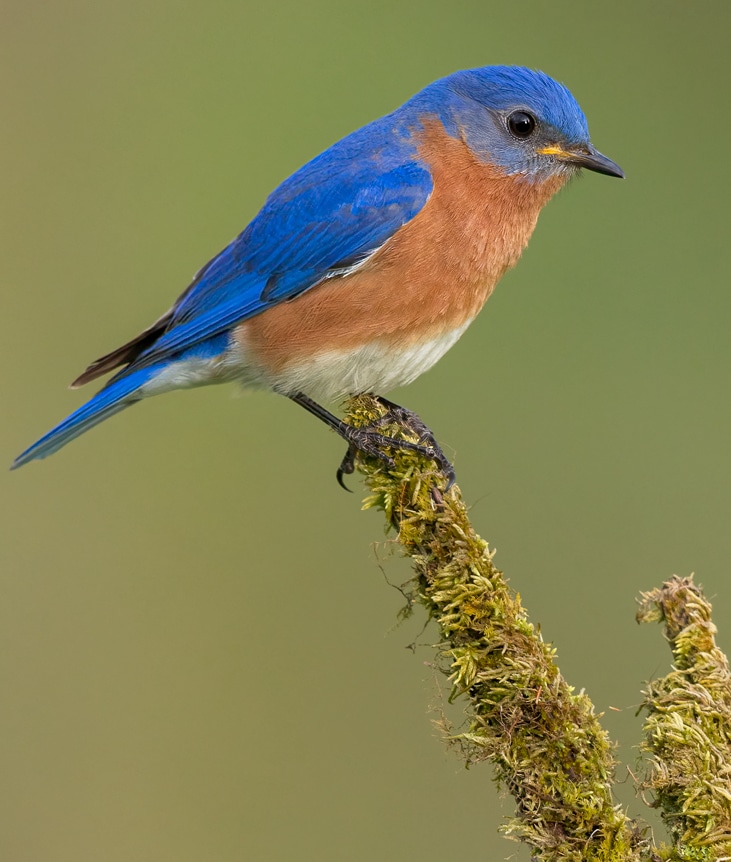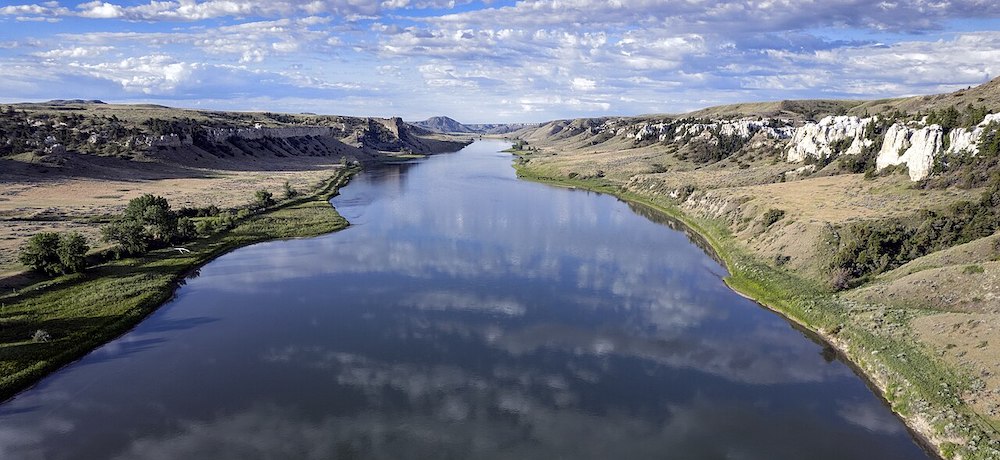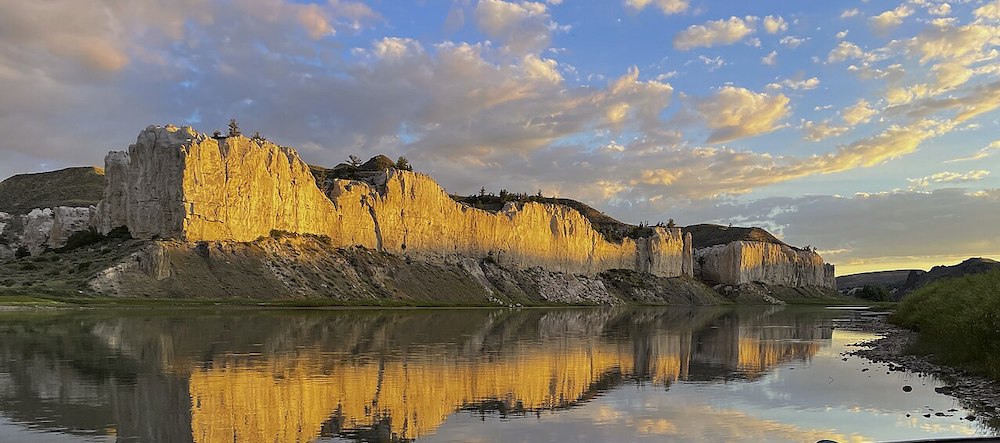State of Missouri

Missouri is a double landlocked state in the Midwestern region of the United States. Covering over 180,000 km2 (almost 70,000 square miles) it ranks 21st in land area. It borders Iowa to the north, Illinois, Kentucky and Tennessee to the east, Arkansas to the south and Oklahoma, Kansas, and Nebraska to the west. In the south are the Ozarks, a forested highland, providing timber, minerals, and recreation. The Missouri River, after which the state is named, flows through the centre and into the Mississippi River, which makes up the eastern border. With around 6.2 million residents, it is the 18th-most populous state of the country. The largest urban areas are St. Louis with more than half a million citizens, Kansas City, Springfield, and Columbia. The capital is Jefferson City.
North of, and in some cases just south of, the Missouri River lie the Northern Plains that stretch into Iowa, Nebraska, and Kansas. Here, rolling hills remain from the glaciation that once extended from the Canadian Shield to the Missouri River. Missouri has many large river bluffs along the Mississippi, Missouri, and Meramec Rivers. Southern Missouri rises to the Ozark Mountains, a dissected plateau surrounding the Precambrian igneous St. Francois Mountains. The southeastern part of the state is known as the Missouri Bootheel region, which is part of the Mississippi Alluvial Plain or Mississippi embayment. This region is the lowest, flattest, warmest, and wettest part of the state. It is also among the poorest, as the economy there is mostly agricultural.[ It is also the most fertile, with cotton and rice crops predominant.

Missouri River – ©Cmichel67, CC BY-SA 4.0 via Wikimedia Commons
Missouri generally has a humid continental climate with cool, sometimes cold, winters and hot, humid, and wet summers. In the southern part of the state, particularly in the Bootheel, the climate becomes humid subtropical. Located in the interior United States, Missouri often experiences extreme temperatures. Without high mountains or oceans nearby to moderate temperature, its climate is alternately influenced by air from the cold Arctic and the hot and humid Gulf of Mexico. Located in Tornado Alley, Missouri also receives extreme weather in the form of severe thunderstorms and tornadoes.
Missouri is home to diverse flora and fauna, including several endemic species. There is a large amount of fresh water present due to the Mississippi River, Missouri River, Table Rock Lake and Lake of the Ozarks, with numerous smaller tributary rivers, streams, and lakes. North of the Missouri River, the state is primarily rolling hills of the Great Plains, whereas south of the Missouri River, the state is dominated by the Oak-Hickory Central US hardwood forest.
Birding Missouri
Located in the centre of the United States, Missouri offers a wide range of habitats and diversity of avifauna. The state is poised at the edge of the Great Plains on the west, and hardwood forests of the eastern US. Missouri’s weather and wildlife is strongly influenced by the great rivers of the American Midwest, the Mississippi and the Missouri.
The state may be divided into two major regions by the west to east passage of the Missouri river. The northern third of Missouri (north of the River) is composed of glaciated plains. These gently rolling lands have, for the most part, been cleared of pre-settlement prairies and riparian woods in preparation for extensive farming. Birds seen in this zone range from Lark Sparrow, and Western Meadowlark at the dry western extremes through Loggerhead Shrike, Dickcissel and other open area species in the centre, to edge/hardwood forest species in the east.
The south-central portion (south of the Missouri River) contains the more rugged terrain of the Ozarks. The eastern half of this region includes dense hardwood forests populated with a variety of Woodpeckers, Wood Thrush, Eastern Wood-Pewee, Kentucky Warblers, and Tufted Titmice (to name but a few). The White River Cedar Glades near the southwestern border of the state contain the highest concentrations of Greater Roadrunners, Prairie Warblers, Blue Grosbeaks, & Painted Buntings.
The southeastern portion of the state (known locally as the boot heel) is composed of Mississippi lowlands. Most of the swampy forests typical of this area have been converted to agricultural use, and the area presently has some of the highest concentrations of Killdeer, American Kestrels, Horned Larks, Red-Winged Blackbirds, and European Starlings in the state.
The west central portions of Missouri are blessed with surviving remnants of the native Tall Grass prairies once common to much of pre-settlement Missouri. In addition to many of the bird species seen in glaciated plains, this region is also home to Scissor-Tailed Flycatchers, Bell’s Vireos, and prairie specific birds like Greater Prairie Chicken, Upland Sandpiper, Short-Eared Owl, Grasshopper Sparrow and Henslow’s Sparrow.
Much of the remainder of the state is Missouri and Mississippi River Lowlands. These river floodplain regions have been significantly developed by the hand of man, leaving the rivers channelized, leveed, locked and dammed to a point where little of the dynamic character of these important bodies of water remains today. Some of the species with greatest abundance in these areas include Yellow Warbler, American Redstart, Warbling Vireo, Least Tern, Fish Crow, Western Kingbird, and Yellow-Headed Blackbird. The Mississippi River lowlands also rest within a major migratory flyway for a variety of species.

Missouri River – ©Cmichel67, CC BY-SA 4.0 via Wikimedia Commons
Around 400 species have been positively identified in the state. Spring and Fall migrations see a wide-ranging variety of eastern and western birds moving through the state. Forty-one species of Wood Warblers have been reported in Missouri, along with 22 Sparrow species, 10 Thrushes, 14 flycatchers, 9 owls, 22 Raptors, and scores of waterfowl, gulls, and shorebirds. Some of the more recent additions to this list include Anna’s Hummingbird, Eurasian Collared Doves, and Smew.
Nearly every corner of Missouri has something unique to offer the serious birder. The state is home to four National Wildlife Refuges: Squaw Creek, Swan Lake, Clarence Cannon, and Mingo, and countless Conservation areas managed by the Missouri Department of Conservation. Some favourite areas frequented by Missouri birders include (but certainly are not limited to) Eagle bluffs Conservation Area near Columbia, Riverlands Environmental Demonstration Area in West Alton, Schell-Osage Conservation Area near Nevada, Lake Jacomo near Kansas City, Otter Slough Conservation Area near Dexter, & Taberville Prairie near Sedalia.
Missouri accommodates an active birding community, which avails us of many useful resources. The Audubon Society of Missouri (ASM) serves as the state’s major ornithological organisation. Spending a bit of time at the following web sites goes a long way toward helping one understand what birding is like in Missouri, but it’s nothing like actually doing it! Come join us, and we’ll be proud to share the best we have with you!
-
Jim Malone
St. Louis MO | stlaud@surfbest.net
-
Mike Beck
Additional Material | grosbeak@discoverynet.com
https://mobirds.org
-
Number of bird species: 440
(As of October 2024) |State Bird: Eastern Bluebird Sialia sialis
-
Avibase
PDF ChecklistThis checklist includes all bird species found in Missouri , based on the best information available at this time. It is based on a wide variety of sources that I collated over many years. I am pleased to offer these checklists as a service to birdwatchers. If you find any error, please do not hesitate to report them. -
Missouri Birding Society
Annotated Listn the table below, clicking on the common name will open a page with detailed species information. -
Wikipedioa
Annotated ListThis list of birds of Missouri includes species documented in the U.S. state of Missouri and accepted by the Missouri Birding Society (MBS). As of July 2021, there are 437 species included in the official list. -
eBird
PDF ChecklistThis checklist is generated with data from eBird (ebird.org), a global database of bird sightings from birders like you. If you enjoy this checklist, please consider contributing your sightings to eBird. It is 100% free to take part, and your observations will help support birders, researchers, and conservationists worldwide.
-
A Guide to Bird Finding in Kansas and Western Missouri
| By John L Zimmerman & Sebastian T. Patti | University Press of Kansas | 1988 | Paperback | 230 pages, 17 illustrations, 26 maps | ISBN: 9780700603664 Buy this book from NHBS.com -
Birds of Missouri
| (Their Distribution and Abundance) | By MB Robbins & DA Easterlea | University of Missouri Press | 1991 | Hardback | 397 pages, b/w photos, distribution maps | Out of Print | ISBN: 9780826207913 Buy this book from NHBS.com -
Birds of Missouri Field Guide
| By Stan Tekiela | Adventure Publications | 2021 | 2nd Edition | paperback | 324 pages, colour photos, colour distribution maps | ISBN: 9781647550851 Buy this book from NHBS.com -
Missouri in Flight
| (The Bird Photography of Mundy Hackett) | by Mundy Hackett | University of Missouri Press | 2007 | hardback | 160 pages, colour photos | ISBN: 9780826217066 Buy this book from NHBS.com
-
Arrow Rock Birds Bees & Blooms Festival
InformationThe Arrow Rock Birds Bees & Blooms Festival was started by the Missouri River Bird Observatory (MRBO) in 2019 in conjunction with the Arrow Rock Garden Market. The festival’s purpose is to raise awareness for animals, plants, and nature in general and provide a fun, family-oriented experience in the surroundings of Arrow Rock.
-
Audubon in Missouri
WebsiteOffices & Chapters; Centers & Sanctuaries; Upcoming Events -
Burroughs Audubon Society
WebsiteThe Greater Kansas City Chapter of the National Audubon Society - 7300 SW West Park Road ~ Blue Springs, MO 64015 -
Columbia Audubon Society
WebsiteThe Columbia Audubon Society’s mission is to preserve the natural world and its ecosystems, focusing on birds and other wildlife, and the earth’s biological diversity through education, environmental study and habitat restoration and protection. -
East Ozarks Audubon Society
Facebook PageMeetings are held at Memorial United Methodist Church, 425 North St, Farmington on the third Thursday of odd months -
Grand River Audubon Society
Information851 Glenwood, Chillicothe, MO 64601 - Terry McNeely -
Greater Ozarks Audubon Society
WebsiteConnecting People with Nature in Our Southwest Missouri Communities... -
Midland Empire Audubon Society
Facebook PageThe Midland EmpireAudubon Society is a chapter of the National Audubon Society, serving NW Missouri, promoting conservation of birds, wildlife and habitat. -
Missouri Bird Records Committee
WebsiteMissouri Bird Records Committee members listed -
Nature Conservatory in Missouri
WebsiteWelcome to the Missouri Chapter of The Nature Conservancy! Here you'll find information on the many ways we're working with the people of the state and the nation to help preserve the diversity of living things by protecting the habitats - land, water, and air - in which they live… -
Ozark Gateway Audubon Society
Facebook Page305 W. Bishop, Carl Junction, MO 64834, 417-438-6213- Ozark Gateway Audubon Society is the local chapter and part of the National Audubon Society… -
Ozark Rivers Audubon Chapter
WebsiteThe Ozark Rivers Chapter is the steward of Audubon Trails Nature Center (Audubon Trails NC). For the nature-lover, conservationist, hiker, runner and biker. Audubon Trails NC is located north of I-44 in Rolla, Missouri. The NC is a unique 70-acre reserve dedicated to community education and habitat preservation. -
River Bluffs Audubon Society
WebsiteThe mission of the River Bluffs Audubon Society is to educate, inform, and inspire the local community so they will actively conserve, enjoy, and restore habitat for birds and wildlife. -
Scenic Rivers Audubon Society
InformationPoplar Bluff, MO 63901 -
St Louis Audubon Society
WebsiteThe St. Louis Audubon Society (SLAS) was established in 1916 as the St. Louis Bird Club. In 1944, the Bird Club became the first local Audubon chapter in the United States. Today, the chapter consists of over 2500 members in 7 counties of Missouri and Illinois. The aims of the St. Louis Audubon Society are to: 1) Conserve native plants, animals, and their habitats; 2) Understand the environmental interrelationships of man with these natural resources and abiotic resources like soil, air, and water; 3) Promote and support the protection and conservation of our local, regional, and global natural systems; and 4) Support conservation and environmental research. -
The Missouri Birding Society
WebsiteFounded in 1901 as The Audubon Society of Missouri, The Missouri Birding Society is a statewide organization dedicated to the preservation and protection of birds and other wildlife forms. Membership is open to all interested in birds. -
Webster Groves Nature Study Society
WebsiteFounded in 1920, Webster Groves Nature Study Society focuses on experiencing nature. Join WGNSS for birds, bugs, & botany! All events are free & open to the public, unless noted.
-
*List of Missouri conservation areas
InformationSatellite ViewThe Missouri Department of Conservation (MDC) administers hundreds of parcels of land in all counties of the state. -
*Missouri State Parks
InformationSatellite ViewFor more than 80 years, the Missouri state park system has preserved and made available to the people of Missouri the best of our state's natural and cultural resources. The mission of the Missouri state park system is to preserve and interpret the state's most outstanding natural landscapes and cultural landmarks, and to provide outdoor recreational opportunities. Preserving Missouri's Natural Landscapes. -
BS Riverlands Migratory Bird Sanctuary
Facebook PageSatellite ViewDesignated as an Important Bird Area by the Audubon Society, the Riverlands Migratory Bird Sanctuary encompasses a total of 3700 acres. Within the Riverlands Migratory Bird Sanctuary is a 1200 acre wetland/prairie restoration project. -
IBA Lower Grand River Wetlands
InformationSatellite ViewThe majority of the Lower Grand River Wetlands IBA south of Linn County occupies the Missouri-Grand River Alluvial Plain, which was historically characterized by wet prairie, with some forest and marsh in the bottomland (Nigh and Schroeder 2002). The northern end of the IBA had some upland prairie, savanna, and woodland. Much prairie has been lost to cropland, but many acres persist as wetlands and bottomland forest on the conservation lands mentioned below. -
NC Audubon Center at Riverlands
WebsiteSatellite ViewOur mission is to connect people to the beauty and significance of the Mississippi River and the Great Rivers confluence, to inspire conservation of the river's rich diversity in birds, wildlife and other natural resources, and to support healthy, vibrant communities. -
NC Burr Oak Woods Conservation Area
WebpageSatellite ViewDiscover Nature at Burr Oak Woods! Burr Oak Woods is a showplace for Missouri's fish, forests and wildlife -- a natural oasis in your own backyard, just 1 mile north of I-70 and minutes from downtown Kansas City. -
NR Shaw Nature Reserve
WebsiteSatellite ViewShaw Nature Reserve strives to inspire responsible stewardship of our environment through education, restoration and protection of natural habitats, and public enjoyment of the natural world. -
NWR Mingo
WebpageSatellite ViewThe 21,592-acre refuge lies in a basin formed in an ancient channel of the Mississippi River. Mingo National Wildlife Refuge is recognized as an Important Bird Area by the Audubon Society as the refuge supports bird species and habitats that are of conservation priority... -
NWR Squaw Creek
WebpageSatellite ViewWelcome to the website for the Friends of the Squaw Creek National Wildlife Refuge located near Mound City, Missouri… -
WiR Bell Mountain Wilderness
WebpageSatellite ViewThe 9,143-acre Bell Mountain Wilderness is part of the St. Francois Mountains, one of the oldest landforms in North America. This is mostly old-growth, oak and hickory forest, with pine and elm, grassy glades, and granite outcroppings.
-
ABA Bird news
SightingsSightings by date -
Missouri Rare Bird Alert
SightingsThe report below shows observations of rare birds in Missouri... -
Missouri Rare Bird Alert
DiscussionMissouri Rare Bird Alert's one purpose: to provide accurate and timely information about chase-worthy birds in Missouri.
-
2018 [05 May] - Steve Hilty - Missouri & Arkansas
PDF Report...We concluded the trip with an exciting morning in the Eleven Point River campground— Swainson’s Warblers chipping and singing, along with American Redstarts, a Prothonotary Warbler, and a Wilson’s Warbler... -
2019 [05 May] - Steve Hilty - Missouri & Arkansas
PDF Report...Birding in Prairie State Park was excellent with resident breeders such as Dickcissels, Brown Thrashers, Bell’s Vireos, and a lovely little Henslow’s Sparrow much in evidence. We also saw a Sedge Wren briefly and found reasonably good floral diversity—Yellow Star Grass, Shooting Stars, Wood Betony, Rose Verbena, False Garlic, and Cream Wild Indigo... -
Recent Trip Reports
Annotated ListeBird
-
Cinnamon Hill B&B
AccommodationSpacious comfortable home located on wooded site within walking distance of Table Rock lake. Watch the birds while a large country breakfast is served…
-
Greater Prairie chicken
InformationA minimum of 4,000 to 5,000 acres of open grassland is believed necessary to support a stable population. As a result, several well managed farms are normally required to provide adequate acreage for a self-sustaining flock… -
Sky Cafe
WebsiteBird food and feeders etc
-
Conservation Conversations
BLOGLast update 2012 - Reflections on environmental education, wildlife issues, and birds; primarily of Southwest Missouri… -
Dodson F@rm
BLOGI am Jack Dodson. My wife, Lorraine, and I and our three children live on a farm in the middle of Missouri. We love nature and are working towards restoring our sixty acres to a more native state. We also have a “bluebird trail” which is a collection of nest boxes or bird houses for bluebirds and other native cavity dwelling birds. I am an amateur photographer and wanted a place to share my experiences and photographs….thus this blog is born.

